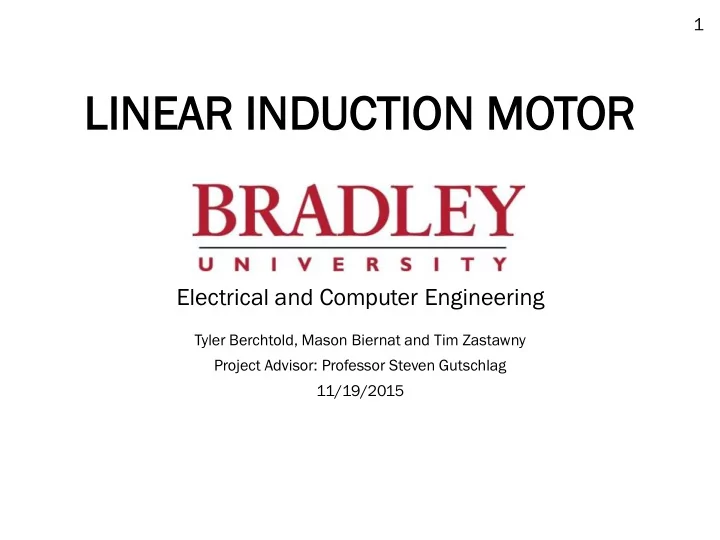

1 LINEAR AR INDUCTION TION MOTOR OR Electrical and Computer Engineering Tyler Berchtold, Mason Biernat and Tim Zastawny Project Advisor: Professor Steven Gutschlag 11/19/2015
2 Outline of Presentation • Project Overview • Tyler • Mason • Tim • Conclusion
3 Outline of Presentation • Project Overview • Tyler • Mason • Tim • Conclusion
4 Project Overview
5 Linear Induction Motor Background • Alternating Current electric motor • Powered by a multiple phase voltage scheme • Force and motion are produced by a linearly moving magnetic field • Used to turn large diameter wheels [1]
6 Alternating Current Induction Machines • Most common AC machine in industry • Produces magnetic fields in an infinite loop of rotary motion • Stator wrapped around rotor [2]
7 Rotary to Linear [3]
8 Subsystem Block Diagram
9 Personal Motivation • To graduate!
10 Gantt Chart Current Project
11 Outline of Presentation • Project Overview • Tyler • Mason • Tim • Conclusion
12 Tyler
13 Progress • Research • Rotary to linear conversion models • Pole arrangements • Overall Microcontroller System • Tachometer • Variable Frequency Drive (VFD) • Liquid Crystal Display (LCD)
14 Tachometer Subsystem • Main Components • Photo-interruptor • Transparent Disk with Notches • External Interrupt • Counts pulses • 4 pulses per rotation • 250 ms interrupt service routine
15 VFD Subsystem • Main Components • VFD • 0-10V signal correlates to 0-120 Hz • A/D Converter • D/A Converter • A/D Converter • Onboard the ATmega128 • 250 ms interrupt service routine • Compares input voltages
16 LCD Subsystem • LCD Displayed Values • RPM • Calculation to obtain RPM • Convert to string • Input string to LCD • Output frequency • Calculation to obtain VFD output frequency • Convert to string • Input string to LCD
17 Gantt Chart
18 Upcoming Work • Implementation of Stator • Full group effort • Microcontroller System • Keypad • Display input keypad value on LCD • Input displayed keypad value to D/A converter • D/A Converter • Input 0-10 V reference signal to VFD • Will change output frequency of VFD
19 Outline of Presentation • Project Overview • Tyler • Mason • Tim • Conclusion
20 Mason
21 Progress • Research • Pole Arrangements • Rotary to Linear Speed • Variable Frequency Drive • Turns per Phase • Calculations • Rotary to Linear Speed • Ideal Linear Synchronous Speed and Frequency • Coil Windings and Turns per Phase • Coil Inductance
22 Work Completed (1)
23 Work Completed (2)
24 Work Completed 4-Pole Machine Using 16 AWG: 2-Pole Machine Using 16 AWG: • 45 Wraps fit on a 0.0762 m • 45 Wraps fit on a 0.0762 m Tooth Tooth • 851 Turns per Phase • 1703 Turns per Phase • 213 Wraps per Stator Tooth • 852 Wraps per Stator Tooth • 5 Coil Wrapping Layers per • 19 Coil Wrapping Layers per Stator Tooth Stator Tooth • Outer Diameter of 0.0362 m • Outer Diameter of 0.0601 m • Coil Inductance of 1.5867 µH • Coil Inductance of 15.4940 µH
25 Work Completed (3) (4) (5)
26 Work Completed Ideal Linear Synchronous Speed vs. Frequency 45 2-Pole Machine (stator length 0.3048m) Output Synchronous Speed [m/s] 40 4-Pole Machine (stator length 0.3048m) 35 30 25 20 15 10 5 0 0 10 20 30 40 50 60 70 80 90 100 110 120 Frequency [Hz]
27 Work Completed Ideal Linear Synchronous Speed vs. Frequency 45 2-Pole Machine (stator length 0.3048m) Output Synchronous Speed [m/s] 40 4-Pole Machine (stator length 0.4542m) 35 30 25 20 15 10 5 0 0 10 20 30 40 50 60 70 80 90 100 110 120 Frequency [Hz]
28 Gantt Chart
29 Outline of Presentation • Project Overview • Tyler • Mason • Tim • Conclusion
30 Tim
31 Progress • Pole Arrangement • Salient • Non Salient • Design Stator • Manufacturing • Cost • Time
32 Pole Arrangements • Understanding poles effect on the system • Number • Will vary overall speed • Will vary output force • Salient • Single coil per tooth • Non-salient or Distributed • Coils distributed around multiple teeth
33 Salient and Non-Salient A B C A B C Salient A B C A B C Non-Salient
34 Design of Stator
35 Design of Stator • Material of LIM • Laminated Steel • Length of teeth • Allow for coil windings to fit
36 Design of Stator • Slot and Teeth Ratio • Narrow Teeth • Generates more force • Better Efficiency • Better Power Factor • Tooth Saturation 25/75 50/50 75/25
37 Manufacturing • Laser Laminations • 1 Week Constructing • Shipping • First Lamination most expensive part of manufacturing • Original 2 Pole Machine cost estimate $250 • New 4 Pole Machine cost raised to $450
38 Gantt Chart
39 Upcoming Work • Purchasing Stator • Winding the coils
40 Outline of Presentation • Project Overview • Tyler • Mason • Tim • Conclusion
41 Conclusion
42 Conclusion • Work Done • Pole Arrangement • Coil Windings • Teeth/ Slot • Design • Future Work • Purchasing • Construction • Implementation • Testing
43 Questions
44 References
45 VFD Photo-Interruptor 0-10 V Pulses Voltage Divider: Interrupt Pulse Counter (½)*(Voltage) 0-5 V Pulses per Interrupt Value Calculation Block: A/D Converter (Count)*(4) [Notches/R]*(1/.25) [s/cycle]*(60 s/min) 0-5 V to Binary 0-5 V to Binary Calculation Block: Float to String (Converter Value)*(10/5) [V]*(120/10) [Hz/V] 0-5 V to 0-120 Hz String input to LCD Float to String LCD String input to LCD LCD
46 Pole Pitch Pole Pitch = 0.1668m τ A B C A B C
47 Coil Pitch http://www.davidsonsales.com/docs_pdf/Coil Pitch.pdf
48 Master Gantt Chart
49 References [1] A. Needham. A maglev train coming out of the Pudong International Airport. [Photograph]. Retrieved from https://en.wikipedia.org/wiki/Maglev#/media/File:A_maglev_train_co ming_out,_Pudong_International_Airport,_Shanghai.jpg [2] Linear Induction Motor. [Photograph]. Retrieved from http://www.mpoweruk.com/motorsac.htm [3] Force Engineering. How Linear Induction Motors Work. [Photograph]. Retrieved from http://www.force.co.uk/linear-motors/how-linear.php
Recommend
More recommend